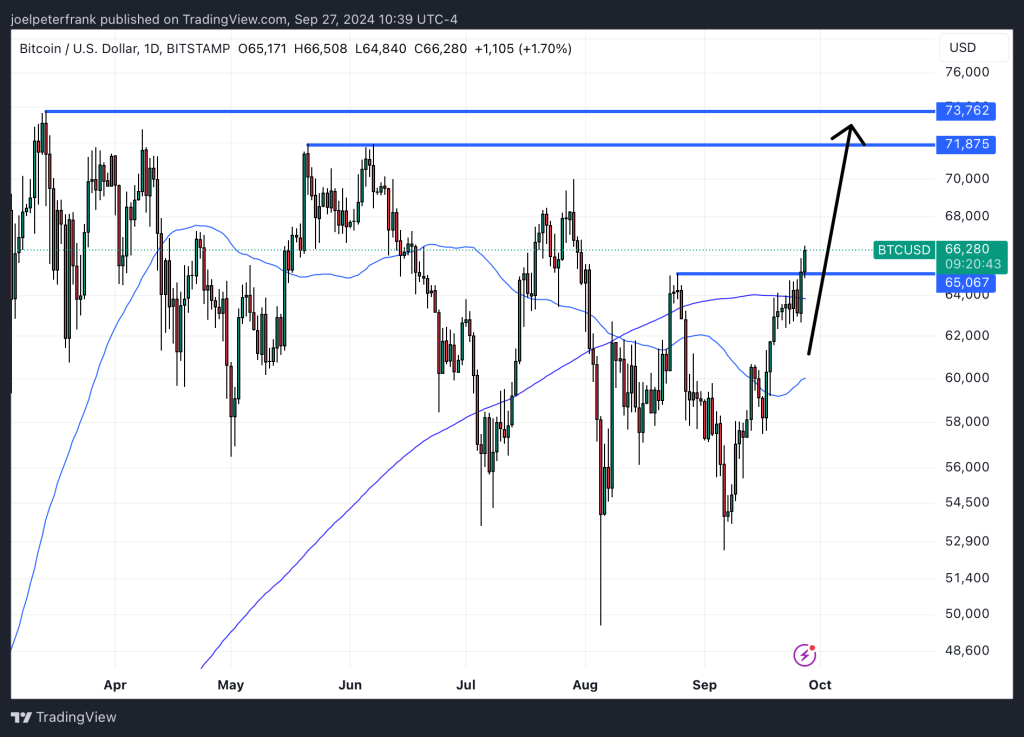Last updated:
 Why Trust Cryptonews
Why Trust Cryptonews

Bitcoin (BTC) surged past $66,000 on Friday, following the release of a softer-than-expected US Core PCE inflation report for August.
The news fueled speculation that the Federal Reserve may ease interest rates faster, potentially helping the US economy avoid a recession in 2025.
This marks the highest Bitcoin price in nearly two months.
The headline PCE price index showed US prices rising at a pace of 2.2% year-on-year, down from 2.5% in July and below the expected 2.3% increase.
Month-over-month, the PCE price index rose by 0.1%, which was in line with economists’ expectations.
Meanwhile, the Core PCE price index increased by 2.7% year-on-year, as expected, but the month-over-month rise of 0.1% was slightly below the forecast.
This modest inflation miss led macro traders to price in a higher likelihood of a 50 basis point (bps) interest rate cut at the Federal Reserve’s upcoming November meeting.
According to the CME Fed Watch Tool, money markets are now pricing in a 53.4% chance of such a rate cut, up from 49.3% the previous day.
Expectations of aggressive monetary easing from the Fed and other major central banks, combined with reduced recession risks, have been a key driver for the Bitcoin price in recent weeks.
Bitcoin price is currently up over 25% from its early September lows of around $52,500 and is set to finish September with a 12% gain.

This performance is especially unusual, as September has historically been one of the worst months for Bitcoin price.
In contrast, October is typically a strong month for Bitcoin, with Q4 generally being a period of bullish momentum.
Where Is the Bitcoin Price Headed Next?
Several factors suggest a potential move higher for the Bitcoin price in the coming quarter.
Seasonality, combined with expectations of a global central bank easing cycle, may set the stage for further gains.
The upcoming US Presidential election in November could also play a major role.
With former President Donald Trump, a known supporter of cryptocurrencies, running against Vice President Kamala Harris, who has recently shown a warming attitude toward the sector, market sentiment could swing based on the election results.
While a Trump victory might accelerate the crypto rally, Harris is not viewed as a negative factor for Bitcoin and the broader crypto industry.
Historical patterns also suggest that the post-halving cycle, which typically leads to significant Bitcoin rallies, will play a role.
According to some analysts, Bitcoin rallies usually intensify about 170 days after the halving event, with market peaks occurring 480 days later.
Though the recent surge in Bitcoin price, driven by strong demand for Bitcoin ETFs, may mean this cycle won’t match previous rallies in intensity, signs still point toward a bullish end to 2024.
Potential Targets and ETF Impact
Institutional demand for Bitcoin via ETFs has increased noticeably in recent sessions, and this trend is expected to continue in the weeks ahead.
Many analysts believe this will become a major talking point in the market, driving further attention to Bitcoin.
Bitcoin bulls are eyeing a retest of key resistance levels, starting at $70,000, followed by a potential attempt to break the all-time highs near $74,000.

If the historical bullish trend for October continues, a breakout to fresh record highs may occur next month.
Some are speculating that Bitcoin could again aim for the $100,000 mark in the near future.
A combination of easing inflation, favorable Federal Reserve actions, upcoming political events, and historical patterns point to the potential for further upside in the Bitcoin price as we move into the final quarter of the year.





